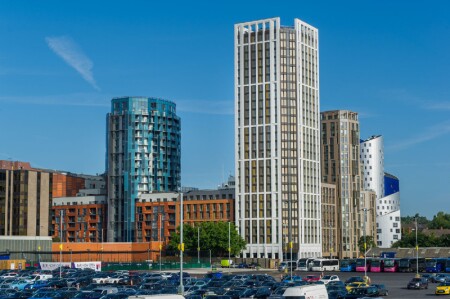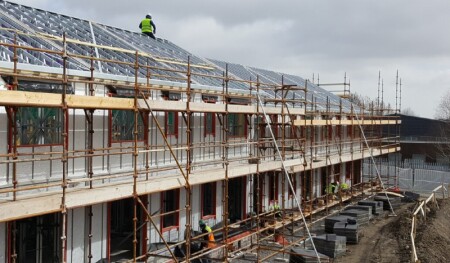Modular construction isn’t new to Europe. In 1066, William the Conqueror took three modular castles with him when he invaded England. In 1599, after a dispute with the landlord, William Shakespeare and his players dismantled the whole Globe Theater in one night.
Beyond portability, industry leaders have seen other plusses to modularity. In 1920, Bauhaus architect Walter Gropius devised a system of prefabrication that he estimated could reduce the cost of building by 50 percent. More recently, architects and entrepreneurs have shown that a modular approach to building can speed up construction by 30 percent, reduce waste by 50 kg per square meter (33.6 lbs per sq ft), and cut CO2 emissions in half.
Yet despite all these advantages—and four or five generations in which almost everything Europeans have worn, sat on, or traveled in has been mass-produced in a factory—people still shy away from mass-produced buildings.
“We are still building today houses the way our grandfathers did 60-70 years ago; we didn’t really industrialize this business,” said Patrick Balemans, head of New Ways, the modular production division of the Etex Group materials manufacturing group in Brussels, Belgium.
A bridge loan too far
This fact has not gone unnoticed. “People who come in from an automotive or technological background, they see huge potential,” Balemans said. They convince a private equity investor to write a check, set up their factory, and wait for the money to come in. And wait. And wait. Until, eventually, the money runs out: in the last six months alone, Balemans said, three modular builders have gone into administration in the United Kingdom.
Balemans’ explanation of what goes wrong is a familiar story in the industry: “These guys had a model which is like automotive—everything is automated with huge capex and a lot of people in the factory. But then the pipeline doesn’t follow. It is not automotive, it is a building, and if you don’t have a building permit, or the economy is going down and for five or six months there are no houses to build, you have a financial problem,” Balemans explained. Or as McKinsey & Co. analysts drily put it in a recent article on modular building, “‘getting paid like a construction company while acting like a technology company is not a promising long-term business model.”
Uneven demand is only the first of many challenges modular builders face.
Distance from the factory to the building site is another limiting factor. A building may be cheaper to construct in a factory but transporting it to the building site can erase the cost advantage of mass production, according to John Banka, senior director of ARC Capital Markets in Warsaw. In a 2019 report on modular building, McKinsey & Co. estimated that in the end, despite substantial savings in production, higher transportation and logistics costs can even lead to a project being 10 percent more than conventional construction.
Regulation is another problem for would-be modular monarchs. “If you have an Apple iPhone, it’s almost the same everywhere in the world. If my building would be an iPhone, that would be fantastic, but that’s not the case. If you build a building in Belgium, the legislation is completely different from France or from Germany or from the United Kingdom. We have to do testing in every country,” Balemans said.
Some observers say builders drag their feet as well. “There is no real sense of urgency by the producers to change the way they’re building,” said Carel van Duuren, founder/CEO of True Modular Building in Sleeuwijk, Netherlands, a company that focuses on multifamily buildings. Between being heavily invested in the equipment to make buildings and a financial incentive to maintain scarcity, van Duuren argues most builders aren’t looking for change.
Finally, construction tends to be a very conservative industry. In Germany, for example, where craftsmen still wear the guild uniforms they have worn for hundreds of years—master carpenters, for instance, wear black vests with silver buttons, and sometimes on special occasions, black broad-brimmed hats and black bell-bottom pants—new ideas aren’t always welcome.
“You have to almost guide the customer, teach the customer what you are doing on the job site, because construction is, as you know, so traditional. People don’t like change,” said Balemans.
But Wolf Mangelsdorf, partner and structural engineer in the London office of Buro Happold, a global engineering and design consultancy, argues that the biggest problem is that modular builders keep trying to sell the wrong product.
“Eighty years we’ve been trying and there’s always another reason it didn’t work but I think we’re completely missing the fundamental,” he said: rooms built in a factory are difficult to transport and still require the use of conventional construction techniques before they can be made into a building. “We’re putting all these boxes together and rain comes into the gaps and we need to put a façade on. And then on the ground floor, we actually have to erect a kind of steel frame…”
Making modular mod
In some specialized segments, modular has made real headway, such as portable kitchens, laboratories, and holiday cabins, particularly in Poland, Sweden, the Netherlands, and the U.K., but broad-market success remains relatively limited. What would it take for modular construction to truly take off?
Balemans thinks deregulation would make a big difference, and a commitment by governments to alleviate the housing shortage by supporting a massive social housing program.
Others see the use of lightweight materials as part of the solution. Marco Huter, managing director of KLH Massivholz in Teufenbach-Katsch, Austria, says cross-laminated timber weighs about 30 percent of what precast concrete does but has the same strength.
Mangelsdorf believed the key to successful modularity is learning to think small. His vision is for manufacturers to create not room-by-room modules according to their own unique designs but for materials producers to develop a wider range of standardized components.
Taking an open-source approach in which interfaces and connections are standardized the way facades already are today would have several advantages, Mangelsdorf said. Contractors would not have to take a risk on a single supplier, builders themselves wouldn’t be limited to a few variations of the same box design, and transporting “a kit of parts” rather than large boxes would eliminate much of the transportation problem many modular builders currently face.
Mangelsdorf has demonstrated some of the possibilities of thinking small in this way with a big commission in Macau, completed in 2017: the wavy, prefabricated steel and glass exoskeleton of City of Dreams, a 40-story leisure and entertainment complex designed by Zaha Hadid. True Modular Building, the Dutch start-up founded by van Duuren, is also pursuing a “kit of parts” approach—albeit with more right angles than the bones of Mangelsdorf’s exoskeleton.
Despite the challenges, modular evangelists remain confident that at some point the building industry will eventually change. “I think it can easily be changed if there is a will and there’s a method,” van Duuren said.
For van Duuren, the case for modular construction is ultimately not just practical, but moral. “It’s ridiculous that people have to pay 40-50 percent of their income on housing,” he said. The environmental costs too make bespoke building a luxury that humanity can no longer afford in this era of climate change. “…[W]e have only one planet, eh?” he asked.







